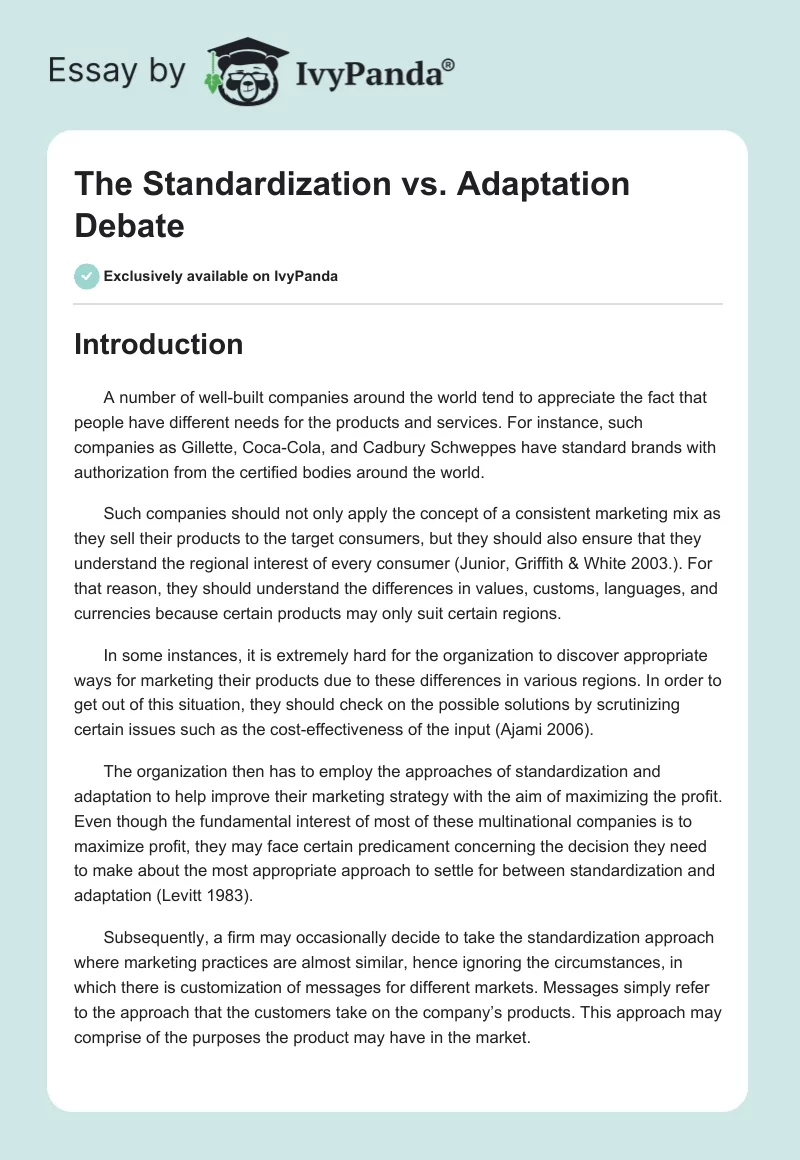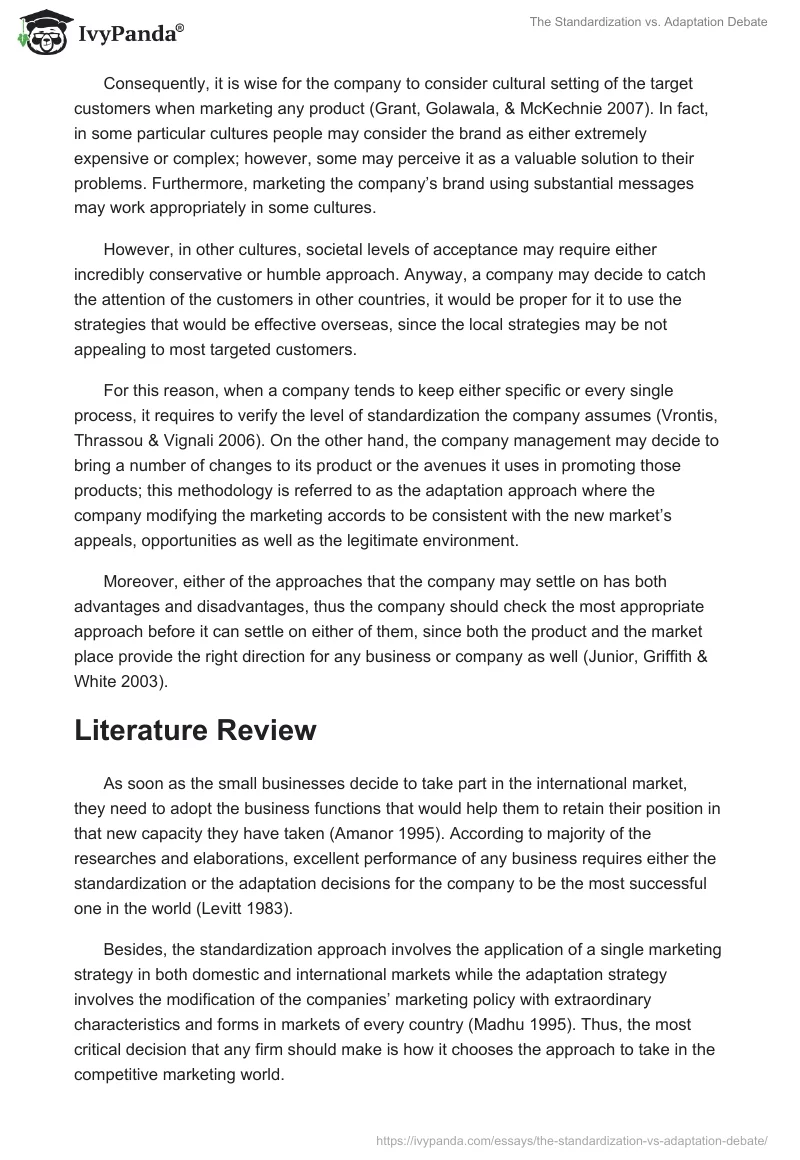Introduction
A number of well-built companies around the world tend to appreciate the fact that people have different needs for the products and services. For instance, such companies as Gillette, Coca-Cola, and Cadbury Schweppes have standard brands with authorization from the certified bodies around the world.
Such companies should not only apply the concept of a consistent marketing mix as they sell their products to the target consumers, but they should also ensure that they understand the regional interest of every consumer (Junior, Griffith & White 2003.). For that reason, they should understand the differences in values, customs, languages, and currencies because certain products may only suit certain regions.
In some instances, it is extremely hard for the organization to discover appropriate ways for marketing their products due to these differences in various regions. In order to get out of this situation, they should check on the possible solutions by scrutinizing certain issues such as the cost-effectiveness of the input (Ajami 2006).
The organization then has to employ the approaches of standardization and adaptation to help improve their marketing strategy with the aim of maximizing the profit. Even though the fundamental interest of most of these multinational companies is to maximize profit, they may face certain predicament concerning the decision they need to make about the most appropriate approach to settle for between standardization and adaptation (Levitt 1983).
Subsequently, a firm may occasionally decide to take the standardization approach where marketing practices are almost similar, hence ignoring the circumstances, in which there is customization of messages for different markets. Messages simply refer to the approach that the customers take on the company’s products. This approach may comprise of the purposes the product may have in the market.
Consequently, it is wise for the company to consider cultural setting of the target customers when marketing any product (Grant, Golawala, & McKechnie 2007). In fact, in some particular cultures people may consider the brand as either extremely expensive or complex; however, some may perceive it as a valuable solution to their problems. Furthermore, marketing the company’s brand using substantial messages may work appropriately in some cultures.
However, in other cultures, societal levels of acceptance may require either incredibly conservative or humble approach. Anyway, a company may decide to catch the attention of the customers in other countries, it would be proper for it to use the strategies that would be effective overseas, since the local strategies may be not appealing to most targeted customers.
For this reason, when a company tends to keep either specific or every single process, it requires to verify the level of standardization the company assumes (Vrontis, Thrassou & Vignali 2006). On the other hand, the company management may decide to bring a number of changes to its product or the avenues it uses in promoting those products; this methodology is referred to as the adaptation approach where the company modifying the marketing accords to be consistent with the new market’s appeals, opportunities as well as the legitimate environment.
Moreover, either of the approaches that the company may settle on has both advantages and disadvantages, thus the company should check the most appropriate approach before it can settle on either of them, since both the product and the market place provide the right direction for any business or company as well (Junior, Griffith & White 2003).
Literature Review
As soon as the small businesses decide to take part in the international market, they need to adopt the business functions that would help them to retain their position in that new capacity they have taken (Amanor 1995). According to majority of the researches and elaborations, excellent performance of any business requires either the standardization or the adaptation decisions for the company to be the most successful one in the world (Levitt 1983).
Besides, the standardization approach involves the application of a single marketing strategy in both domestic and international markets while the adaptation strategy involves the modification of the companies’ marketing policy with extraordinary characteristics and forms in markets of every country (Madhu 1995). Thus, the most critical decision that any firm should make is how it chooses the approach to take in the competitive marketing world.
Obviously, each of the “5Ps” of marketing known as Product, Price, Promotion, People and Place necessitates examination in order to make the right decision for maximization of the profit. Moreover, other “2Ps” are included in these strategies, which is determined by some aspects of marketing to ensure positive improvement in the business (Spence, Rutherfoord, Blackburn 1998).
Subsequently, this would ensure that some small companies that are interested in joining the global market to save some money on the essential activities such as production, market research, and development of distribution channels and value chain partners. Below is the illustration of the above concept (Lages, Abrantes & Lages 2008).
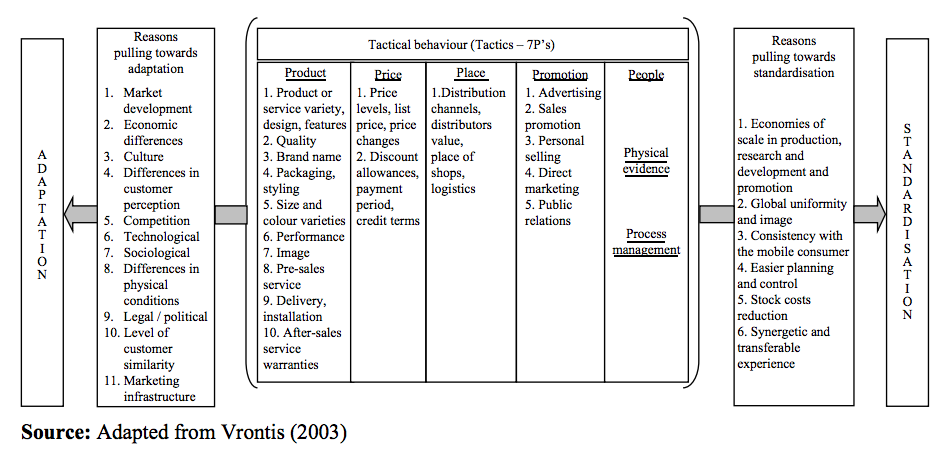
Both the approaches have advantages and disadvantages to the firm depending on which method the firm decides to have.
Pros and Cons of Standardization
To begin with, standardization has several advantages, which include the following: the uniformity of the product in the globe as well as the cost savings from having identical products. Indeed, it helps in reducing the cost especially when the firm produces the identical products and uses the recognized marketing and distribution systems enabling the company to have the benefits in production and marketing of its products and its performance in the international market (Buzzell 1968).
Besides, it leads to advancement in the administration and strategies, hence necessitating less customization; this would facilitate the exchange of mechanisms that would offer practical application of expert understanding and improvement of the performance of the firm. Furthermore, there is strengthening of the image of the product as well as the firm because of the international harmonization, which results from an international involvement by the company.
Hence, this attribute is exceptionally more advantageous when launching a product in several countries at the same time (Lages, Abrantes & Lages 2008). Due to a single coherence in the global image of the standardization approach, the same advertising standpoint in most of the markets would grant the product, the firm and the brand as well to possess a uniform image in the market.
Therefore, this would reduce confusions, since the consumer is mobile all over the world and due to various types of the advertising media such as television which consumers watch to know what he or she can access internationally, especially when they watch the foreign television programs (Chang 1995). In addition, any firm that uses the standardization strategy in marketing would not experience any form of resistance from any communication agencies.
This would be due to the accountability they have for setting up a single communication campaign. In fact, the creativity of firm determines the type of the communication system it would use for effective performance globally (Paliwoda &Ryans 1995). Beyond doubt, the firm also experience economies of scale, which is incredibly fundamental for the success of the firm globally.
Therefore, there would be more savings due to the allowance obtainable and due to the big quantity of acquirement and a balanced distribution of resources as well, especially on the diverse markets. Consequently, the firm can cut down while using the universal strategy at the global level or employing unique marketing programs, apparently, due to the above argument, the companies can easily offer better and certain products at lower prices (Buzzell 1968).
On the other hand, this approach has several disadvantages both to the consumers and to the affected firm. These disadvantages include the loss of uniqueness and the negative flexibility in the execution of the activities in the firm due to standardization (Hildebrandt 1981). For instance, in case a company develops a customer base that can serve a specialized market, therefore, standardizing its methods would mean that it loses some of its previous customers.
Besides, there may be the loss of awareness; it may appear when the business spreads out into a new market; the reason may be the cultural diversity that can lead to dissimilar tastes and likings of the market by the consumers. This can result in quite many deficits particularly in crucial shares of the market and damage to the impression of the product in the long term as well.
Thus, this can set up undesirable responses on the part of the consumers, as it does not represent their own interest; this may make the firm not to compete effectively in the international market (Levitt 1983). Further, there is an inadequate motivation for local bureaus. This is because of inadequate communication between the personnel in the company or the agencies and the consumers.
In addition, they may not effectively commit themselves to the production and formation as well. Nonetheless, the standardization approach may be more inadaptable at times specifically when it maintains the local conditions (Papavassiliou & Stathakopoulos 1997).
Pros and Cons of Adaptation
Aside from the standardization method, the firm can decide to use the adaptation method to their products. This marketing strategy has also several advantages and disadvantages to the firm and the market as well. This approach has the advantages discussed below for both the customers and the company globally and locally (Solberg 2000). There is the value for local conditions and opportunities as well.
For instance, a company that uses the idea of systematic adaptation can succeed in the competition since it intensifies its chances of improvement through proper responses to the anticipations of local consumers and legislation. Besides the firm that employs this methodology has an excellent image to the local market. This can be due to the company’s effort to cater for the specific needs of the local market (Roostal 1963).
The companies can also become more responsible as they take part in the creation of the healthier communication policy between the company and the locals, hence leading to the motivation of the local agencies. Lastly, there are flexibility and strong reactivity to the actions of local competitors, since the approach tends to understand and appreciate their existence and participation in the market through giving them the fundamental precedence in the market (Vrontis & Vignali 1999).
In spite of all these advantages, this approach has quite a lot of disadvantages for both the firms and the customers. To begin with, there are higher costs associated with this methodology. Definitely adapting the policy to every target market does not set aside for cost cutting measures for the firms to make. Furthermore, there is the risk of disparity of the impression of the company particularly in the international market.
Subsequently, this may lead to suffering from the global policy of the company (Theodosiou & Leonidou 2003). To certain extent, the company may find it difficult while it needs to control its advertising policies and methods as well. Further, there may be no cooperation following the actions between the local and the global markets.
Then the alignment of the activities of the company may be challenging due to the differences between communication strategies in the market including those that are also close with each other geographically. Ultimately, there is poor speed of execution of any activity within the market (Vrontis 2003).
Discussion
Actually, there are two critical strategies that are usually available for the firms when resolving to participate in the international marketing; they include the standardization and adaptation policies. As soon as a firm has decided to join the foreign markets, it would be wise for it to opt for the marketing strategy it would use to operate in the market.
For instance, most of the Australian and New Zealand firms operating in the Greater China region employ the adaptation policy in which they are often associated with various factors such as the government regulations, economic development, competitive environment, the immigrants effects between the employee and the employer as well as the product life cycle (Frandsen 1997).
Formerly there have been quite a lot of deliberations in different nations around the world on the best strategy that the firms should use. In fact, the most concerned individuals have come up with different opinions based on the facts that several multinational companies use numerous marketing strategies to market their product in the competitive international markets.
For that reason, they take into account diverse factors that are associated with either of the approaches. For instance, standardization-marketing strategy occurs when there is global recommendation of common product, price, distribution, as well as its promotion (Fatt 1964). This approach can only work best for the firm under certain conditions, the fundamental factor uses a limited budget.
Apparently, a standardized campaign costs less than an adapted one. That is why some SMEs companies in Britain tend to standardize their communication due to the limited budgets they usually have. Moreover, standardization ensures market harmonization and uniformity in the performance.
Perhaps the differences in market consumption of some global products may not be effective, since they have similar functions internationally, although in Europe, America and Japan, the segments of the population that consume such products have similar needs, sales expectations and purposes. Hence they would want their products to have the same qualities.
For example, luxury products, certain clothes, as well as the hotel industry. Therefore, it would be wise for the companies who are interested to operate in these countries to use the standardization policy (Dow 2001). Likewise, the industrial nature of the product is also one of the major factors that a company that is interested in using the standardization approaches for marketing its products should consider.
For instance, advertisement will be generally easier to standardize for industrial products than for goods for consumption. In fact, industrial products are almost similar; therefore, the customers buy and use them in the same way in various countries (Elinder 1961).
Except for the standardization, there is adaptation approach that the scholars have always deliberated upon that the firms should also consider as the alternative to their marketing strategies. Besides, there are several that a firm should consider. First, the company should check on the socio-cultural differences. This is because people from diverse cultures differentiate themselves by their demands and by their satisfaction too (Vrontis n.d).
This is evident in countries in Europe for companies such as Nokia to use this strategy to market their products. Therefore, companies that sell international products to population with a certain life style rather than by ethnicity or nationality such as France, German and American should apply the adaptation method (Buzzell 1968).

The figures below show the cultural factors in the international market.

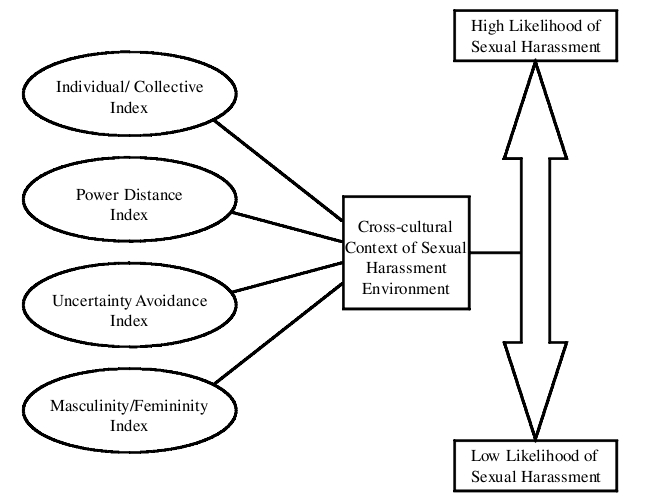
Indeed the aims of both methods are to target the market as illustrated by the figure below.
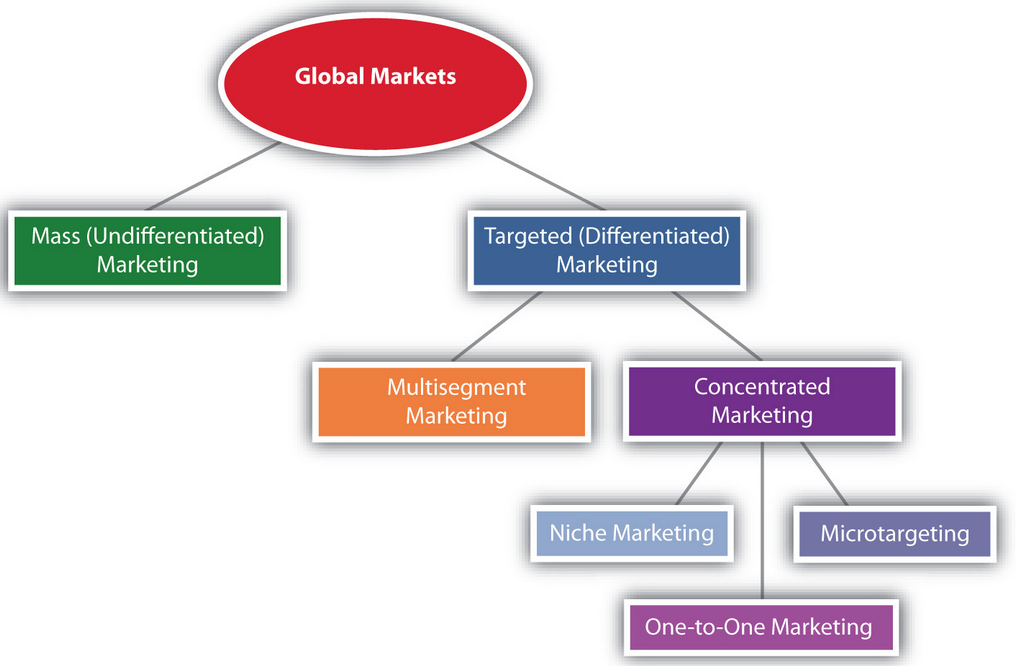
The Adapt-Stand Model (Hybridization)
Following the studies carried out by various scholars on these two methodologies, it would be, therefore, appropriate for the firm to settle on either one or both of the strategies while marketing its products (Hawk 2007). Therefore, the above model refers to the resolution to pick either one or both of the approaches. Moreover, studies survey these aspects as they have greater influence on the market. Most companies use these effects in foreign countries (Albaum & Tse 2001).

Conclusion
Concisely, according to the researches that have been carried on the marketing structure, the scholars recommend that the companies should use the standardization methods since it has more advantages than disadvantages as compared to adaptation approach (Vignali & Vrontis 1999).
List of References
Albaum, G., & Tse, D. K, 2001, ‘Adaptation of International Marketing Strategy Components, Competitive Advantage, and Firm Performance: A Study Of Hong Kong Exporters’, Journal of International Marketing, vol. 9, no. 4, pp. 59-81.
Ajami, R. A 2006, International business theory and practice (2nd ed.), M.E. Sharpe, Armonk, N.Y.
Amanor, K. S 1995, ‘Dynamics of Herd Structures and Herding Strategies in West Africa: A Study of Market Integration and Ecological Adaptation’, Journal of the International African Institute, vol. 65, no. 3, pp. 351.
Buzzell, R.D, 1968, ‘Can you standardize multinational marketing?’, Harvard Business Review, vol. 16, no. 7, pp. 89-110.
Chang, T 1995, ‘Formulating Adaptive Marketing Strategies In A Global Industry’, International Marketing Review, vol. 12, no. 6, pp. 5-18.
Elinder, E 1961, ‘How international can advertising be?’, International Advertiser, vol. 11, no. 4, pp. 12-16.
Dow, D, 2001. ‘The Adaptation of Host Market Positioning Strategies: Empirical Evidence on Australian Exporters’, Journal of International Marketing, vol. 12, no. 3, pp. 41-62.
Fatt, A. C 1964, ‘A Multinational Approach to International Advertising’, International Advertiser, vol. 56, no. 9, pp.17-20.
Frandsen, V 1997, ‘Standardization Versus Adaptation Of International Advertising Strategies: Towards A Framework’, European Journal of Marketing, vol. 31, no. 7, pp. 504-527.
Gorman, G, Hanlon, D, and King, W 1997, ‘Some research perspectives on entrepreneurship education, enterprise education and education for small business management: a ten-year literature review’, International Small Business Journal, vol. 15, no. 3, pp. 56-77.
Grant, J., Golawala, F. S., & McKechnie, D. S 2007, The United Arab Emirates: The Twenty-first Century Beckons, Thunderbird International Business Review, vol. 49, no. 4, pp. 507-533.
Hawk, M 2007, Adapt Stand Country of Origin 2007. Web.
Hildebrandt, H. W 1981, International business communication: theory, practice, teaching throughout the world, Division of Research, Graduate School of Business Administration, Michigan.
Junior, JK, Griffith, DA, & White, DS 2003, ‘Standardization/adaptation Of International Marketing Strategy: Necessary Conditions for the Advancement of Knowledge’, International Marketing Review, vol. 20, no. 6, pp. 588-603.
Lages, L. F., Abrantes, J. L., & Lages, C. R 2008, ‘The Stratadapt Scale: A Measure Of Marketing Strategy Adaptation To International Business Markets’, International Marketing Review, vol. 25, no. 5, pp. 584-600.
Levitt, T 1983, ‘The globalization of markets’, Harvard Business Review, vol. 17, no. 8, pp. 79-95.
Madhu, A 1995, ‘Review of a 40-year debate in international advertising: practitioner and academician perspectives to the standardization/adaptation issue’, International Business Review, vol. 12, no. 1, pp. 26-48.
Paliwoda, S. and Ryans, Jr. J 1995, International Marketing Reader, Routledge, London.
Papavassiliou, N. and Stathakopoulos, V 1997, ‘Standardization versus adaptation of international advertising strategies: towards a framework’, European Journal of Marketing, vol. 31, no. 7, pp. 504-27.
Roostal, I, 1963, ‘Standardization of Advertising for Western Europe’, Journal of Marketing, vol. 27, no.4, pp.15-20.
Solberg, CA 2000, ‘Standardization or Adaptation of the International Marketing Mix: The Role of the Local’, Journal of International Marketing, vol. 8, no. 1, pp.78-98.
Spence LJ, Rutherfoord R, Blackburn RA 1998, Small Businesses and Environmental Issues in the UK and the Netherlands: A Literature Review and Research Agenda, Kingston Business School, United Kingdom.
Theodosiou, M 2003, Standardization versus Adaptation of International Marketing Strategy: An Integrative Assessment of the Empirical Research,’ International Business Review, vol. 12, no. 2, pp. 141-171.
Vrontis, D, Thrassou, A & Vignali, C 2006, ‘The country-of-origin effect, on the purchase intention of apparel – opportunities and threats for small firms’, International Journal of Entrepreneurship and Small Business, vol. 3, no. 3/4, pp. 459-476.
Vrontis, D & Vignali, C 1999, An International Marketing Reader, The Manchester Metropolitan University, Manchester.
Vrontis, D, 2003, ‘Integrating adaptation and standardization in international marketing, the AdaptStand modelling process’, Journal of Marketing Management, vol. 19, no. 4, pp. 357-380.
Vrontis, D n.d., The Creation of the AdaptStand Process in International Marketing, Academia.edu. Web.

